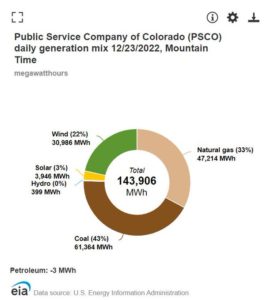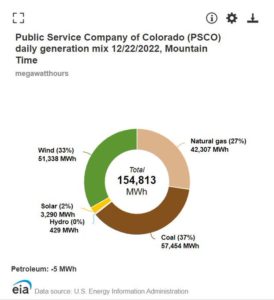DENVER — During the recent Arctic blast, it was fossil fuels that kept Colorado warm, yet the Public Utilities Commission (PUC) continues to move forward on a plan to make natural gas lines more cost prohibitive on any new construction, while local governments eye outright bans.

According to the U.S. Energy Information Administration, on day two of Colorado’s recent, record-setting subzero temperatures, and despite the heavy winds that blew for nearly a week, coal contributed the largest portion of fuel Xcel Energy used in generating electricity to heat homes and businesses (43 percent), with natural gas second at 33 percent, wind next at 22 percent and solar at just 3 percent.
“Because the cold front blew in with the wind, early on, wind was creating more than 30 percent of the energy,” said Jake Fogleman, energy policy analyst at the *Independence Institute, a free market think tank in Denver. “It gave a pretty strong showing, but the rest of it was mostly coal, and a pretty large chunk of natural gas.”
Fogleman was referring to statistics from the first day of the cold front when wind production (33 percent) of electricity came in second to coal (37 percent), with natural gas at 27 percent and solar at 2 percent.
Solar does not ever contribute much more than 2-4 percent of the electric needs in Colorado according to the U.S. Energy Information Administration.
Fogleman pointed out that the statistics were also only for electric-generated heat.
“Seventy percent of Colorado homes use gas directly for heat,” Fogleman said. “So, on top of electricity being generated for heat, there was gas being burned for heat.”
The month of December shows the percentage of wind-generating electricity in Colorado ranged from a low of 14 percent to a high of 47 percent. A random sampling included:
- 47 percent on December 2
- 29 percent on December 6
- 44 precent on December 12
- 22 percent on December 17
- 14 percent on December 18
- 22 percent on December 23
- 45 percent on December 27
Coal and natural gas consistently make up the largest percentage of electric heat generation.
Despite evidence showing the need for coal and natural gas, the PUC approved a plan intended to scale back the use of gas in new homes.
The latest approval is a scaled back version of its first proposal that would have ended the practice of developers and energy companies splitting the cost of natural gas lines in new developments. Until now, as in most other states, providers, such as Xcel Energy and Atmos Energy, pass their share of the costs onto their rate payers in the form of fees.

Under the first proposal, developers would bear the entire cost of hooking homes up to the natural gas system, which in turn would be passed on to the buyers, increasing an already high cost of housing in Colorado. The idea would follow a similar law in California as an effort to reach Colorado’s climate goals.
The new version created an equation to determine who pays how much and includes such things as the actual cost to lay new lines and expand existing lines as well as the “social cost of carbon” — an idea that attempts to estimate perceived financial impact from greenhouse gas emissions.
The actual equation and what it means won’t be finalized for another year.
But it’s not just the PUC moving against natural gas as an energy source. In August, Crested Butte became the first Colorado local government to enact a ban on natural gas for new commercial and residential construction, a form of forced electrification despite well documented concerns over grid reliability.
And earlier in December, the Denver City Council declined to enact a similar ban for new homes, but indicated a willingness to revisit the issue after more study.
Fogleman said it is unrealistic to think that Colorado could ever depend on wind or solar for the lion’s share of electric production. People need natural gas to heat their homes and businesses year-round, but more importantly, cold spells like the one Colorado experienced just days before Christmas could turn deadly without natural gas or coal.
Fogleman called wind a “wildcard” in Colorado.
“It doesn’t matter how rare these cold spells are, they are still deadly,” Fogleman said. “Cold kills and Coloradans need to be able to count on power that is going to get them through these times. We can’t just hope and pray that the wind is going to keep blowing and the turbines aren’t going to freeze, and we don’t have to white-knuckle our way through a storm.”
*The Independence Institute is the publisher of Complete Colorado.


